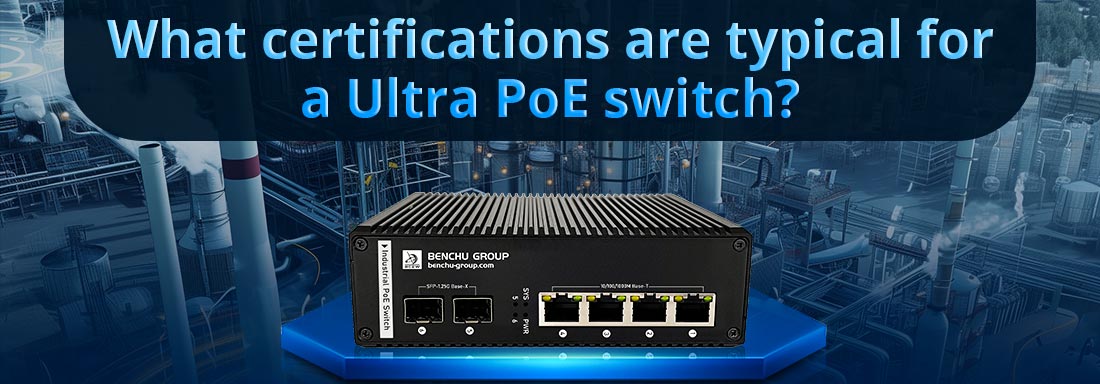
Les commutateurs Ultra PoE (Power over Ethernet) portent souvent plusieurs certifications qui garantissent leur fiabilité, leurs performances, leur sécurité et leur conformité aux normes de l'industrie. Voici une description détaillée des certifications typiques associées aux commutateurs Ultra PoE :
1. Conformité aux normes IEEE
IEEE 802.3af : Cette norme définit les spécifications du PoE, permettant aux appareils de recevoir de l'alimentation et des données via le même câble Ethernet. Il spécifie une puissance de sortie maximale de 15,4 watts par port.
IEEE 802.3at (PoE+) : Une amélioration de la norme PoE d'origine, PoE+ augmente la puissance de sortie maximale à 30 watts par port. Cette certification est importante pour les appareils qui nécessitent plus de puissance, tels que les caméras panoramique-inclinaison-zoom (PTZ) et les points d'accès sans fil.
IEEE 802.3bt (PoE++) : La dernière norme permet une puissance encore plus élevée, jusqu'à 60 watts par port (Type 3) et 100 watts (Type 4). Le respect de cette norme est crucial pour les appareils qui ont des demandes de puissance élevées.
2. Certifications de sécurité
Certification UL : La certification Underwriters Laboratories (UL) indique que le commutateur a été testé selon les normes de sécurité en Amérique du Nord. Il garantit que l'interrupteur répond aux exigences spécifiques de sécurité électrique, réduisant ainsi le risque de choc électrique, les risques d'incendie et d'autres problèmes de sécurité.
Marquage CE : Le marquage CE indique que l'interrupteur est conforme aux normes européennes en matière de santé, de sécurité et de protection de l'environnement. Cette certification est obligatoire pour les produits vendus dans l'Espace économique européen (EEE).
Conformité FCC : La certification de la Federal Communications Commission (FCC) est requise aux États-Unis et indique que le commutateur répond à des normes spécifiques en matière d'interférences électromagnétiques (EMI), minimisant ainsi le risque de perturbation d'autres appareils électroniques.
3. Certifications environnementales
Conformité RoHS : La certification RoHS (Restriction of Hazardous Substances) garantit que l'interrupteur est exempt de certaines matières dangereuses, telles que le plomb, le mercure, le cadmium et certains retardateurs de flamme. Cette certification promeut la durabilité environnementale et la sécurité.
Conformité DEEE : La certification Déchets d’Équipements Électriques et Electroniques (DEEE) est liée à l’élimination des déchets électroniques. Il garantit que le fabricant propose des options appropriées de recyclage et d’élimination pour le commutateur à la fin de son cycle de vie.
Indices IP : Bien qu'il ne s'agisse pas d'une certification au sens traditionnel, les indices de protection (IP), tels que IP40 ou IP65, indiquent la résistance du commutateur à la poussière et à l'eau. Ceci est particulièrement important pour les interrupteurs utilisés dans des environnements extérieurs ou industriels.
4. Certifications de gestion de la qualité
ISO9001 : Cette certification signifie que le fabricant suit les principes de gestion de la qualité, garantissant une qualité constante des produits et une amélioration continue. La certification ISO 9001 est importante pour établir la confiance dans la fiabilité et les performances du commutateur.
ISO 14001 : Cette certification se concentre sur les systèmes de gestion environnementale et indique que le fabricant s'engage à réduire son impact environnemental. Ceci est particulièrement pertinent pour les organisations à la recherche de produits durables et respectueux de l’environnement.
5. Certifications de réseau et de performances
IEEE 802.1Q : Cette certification concerne le balisage VLAN (Virtual Local Area Network) et est essentielle à la gestion du trafic réseau. La conformité à cette norme est importante pour les commutateurs utilisés dans des environnements réseau complexes.
IEEE 802.1P : Cette certification concerne la Qualité de Service (QoS) pour prioriser le trafic réseau. La conformité garantit que le commutateur peut gérer efficacement les flux de données et prendre en charge les applications nécessitant des performances fiables, telles que la voix sur IP (VoIP) et la vidéoconférence.
6. Tests et certification pour des applications spécifiques
Conformité NEBS (système de construction d'équipements réseau) : Pour les équipements de télécommunications et de réseau, la conformité NEBS indique que l'équipement répond à des normes spécifiques en matière de fiabilité et d'exigences environnementales, en particulier dans les environnements de télécommunications.
Conformité MIL-STD : Pour les commutateurs destinés aux applications militaires ou de défense, la conformité aux normes militaires (MIL-STD) garantit robustesse et fiabilité dans des conditions difficiles, notamment des températures extrêmes et des contraintes environnementales.
Conclusion
Ultra Commutateurs PoE disposent généralement d'une gamme de certifications qui soulignent leur adhésion aux normes de sécurité, de performance, d'environnement et aux meilleures pratiques de l'industrie. Des certifications telles que la conformité IEEE pour les normes PoE, des certifications de sécurité comme UL et CE et des certifications environnementales comme RoHS et WEEE sont essentielles pour garantir que ces commutateurs peuvent fournir de l'énergie et des données de manière fiable tout en répondant aux attentes réglementaires et des clients. Ces certifications renforcent non seulement la crédibilité du produit, mais fournissent également une assurance aux utilisateurs concernant la sécurité, la fiabilité et la responsabilité environnementale des équipements qu'ils choisissent pour leur infrastructure réseau.